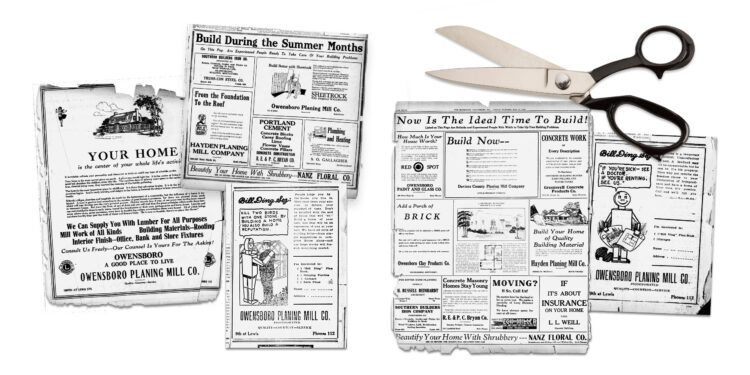There may not have been an official Parade of Homes in Owensboro-Daviess County back in 1925, but our ancestors were certainly thinking and talking about the same things that are on our minds a century later.
That includes the many aspects of homebuilding — everything from choosing materials like wood, brick, or sheetrock to deciding on the details: foundations, electrical and plumbing systems, roofing, windows, paint and wallpaper, fencing, landscaping, and so much more.
Of course, building a home begins with a floor plan, and there were many to choose from 100 years ago. As just one example, a charming bungalow offered a variety of amenities, including a kitchen with a built-in breakfast alcove and a back-door entry that allowed the refrigerator to be iced from the rear stoop. Potential builders were given the option of a basement with an amusement room, laundry, furnace and fuel rooms; or one could omit the basement and construct the home on concrete or brick piers, “with lattice between for circulation to prevent dry rot.”
The price? “With hardwood floors and trim, this house should be built for $5,000 to $6,000, exclusive of heating and plumbing.”
Home ownership — then as now — was celebrated as a proud achievement for any individual or family. Owensboro Planing Mill, which published a series of advertisements featuring words of wisdom from their mascot “Bill Ding” (Haha! Get it?), reminded readers that “Renting is a temporary makeshift. Unsatisfactory at best.”
Bill Ding also suggested that “People judge you by the house you live in. They read there your success or failure; your standard of taste. Don’t be satisfied with the short of house that will ‘do.’ Build a home of your own, one that will be an expression of you at your best.”
Not to mention that it was practically the duty of every responsible parent to purchase or build a home in which his children could thrive: “Normal healthy, fun-loving children require ample space in which to play. Build a home of your own that includes a nursery for rainy days and a bit of ground for sunny weather. … We suggest that you include in your order materials for a sand-pile, playhouse, see-saws. The children will be delighted and you will be more than repaid in watching their sturdy, happy growth.”
But there was still a market for rental homes in 1925, just as there is today. An article published on Sept. 9 in the Owensboro Messenger reported that smaller houses were much in demand: “The day of the many room house and the several parlors and halls has gone in Owensboro,” the writer stated. “People now desire just the number of rooms they can get by with. Three or four room apartments are popular. People are now … getting ready for winter and looking for heated apartments. People moving in from the country to send their children to school … are taking up the vacant houses.”
As another benefit, the article went on to say, “Both in renting and in buying, families are desiring smaller quarters, which are easier to take care of and are not such a care on the housewife as the former spacious homes.”
In fact, some owners of “the larger and more commodious houses” were converting their homes into apartments and duplexes, “the owners living in one of the apartments and leasing the remainder, making the former big home a source of revenue, and yet a home for other families.”
But at the end of the day, the words of another advertisement ring as true today as they did then: “Your home is the most sacred place on earth … the center of living for the family … the most important place in childhood. Lincoln, and many others of our great statesmen, were born in humble log homes; nevertheless, these were homes. All of which brings out more forcibly than ever the truth of those well known lines: ‘Be it ever so humble, there’s no place like Home.’” OL










